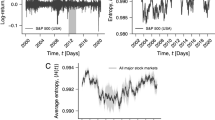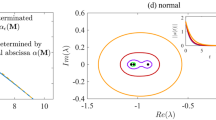Abstract
Financial prices have been found to exhibit some universal characteristics1,2,3,4,5,6 that resemble the scaling laws characterizing physical systems in which large numbers of units interact. This raises the question of whether scaling in finance emerges in a similar way — from the interactions of a large ensemble of market participants. However, such an explanation is in contradiction to the prevalent ‘efficient market hypothesis’7 in economics, which assumes that the movements of financial prices are an immediate and unbiased reflection of incoming news about future earning prospects. Within this hypothesis, scaling in price changes would simply reflect similar scaling in the ‘input’ signals that influence them. Here we describe a multi-agent model of financial markets which supports the idea that scaling arises from mutual interactions of participants. Although the ‘news arrival process’ in our model lacks both power-law scaling and any temporal dependence in volatility, we find that it generates such behaviour as a result of interactions between agents.
This is a preview of subscription content, access via your institution
Access options
Subscribe to this journal
Receive 51 print issues and online access
$199.00 per year
only $3.90 per issue
Buy this article
- Purchase on Springer Link
- Instant access to full article PDF
Prices may be subject to local taxes which are calculated during checkout



Similar content being viewed by others
References
Mandelbrot, B. The variation of certain speculative prices. J. Bus. 35, 394–419 (1963).
Fama, E. Mandelbrot and the stable Paretian hypothesis. J. Bus. 35, 420–429 (1963).
Mantegna, R. N. & Stanley, E. Scaling behaviour in the dynamics of an economic index. Nature 376, 46–49 (1995).
Ghashgaie, S., Breymann, W., Peinke, J., Talkner, P. & Dodge, Y. Turbulent cascades in foreign exchange markets. Nature 381, 767–770 (1996).
Galluccio, S., Caldarelli, G., Marsili, M. & Zhang, Y. -C. Scaling in currency exchange. Physica A 245, 423–436 (1997).
Liu, Y., Cizeau, P., Meyer, M., Peng, C. -K. & Stanley, H. E. Correlations in economic time series. Physica A 245, 437–440 (1997).
Fama, E. Efficient capital markets: a review of theory and empirical work. J. Fin. 25, 383–417 (1970).
Shleifer, A. & Summers, L. H. The noise trader approach to finance. J. Econ. Perspect. 4, 19–33 (1990).
Palmer, R. G., Arthur, W. B., Holland, J. H., LeBaron, B. & Tayler, P. Artificial economic life: a simple model for a stockmarket. Physica D 75, 264–274 (1994).
Levy, M., Levy, H. & Solomon, S. Microscopic simulation of the stock market: the effect of microscopic diversity. J. Phys. I (France) 5, 1087–1107 (1995).
Bak, P., Paczuski, M. & Shubik, M. Price variations in a stock market with many agents. Physica A 246, 430–453 (1997).
Caldarelli, G., Marsili, M. & Zhang, Y. -C. Aprototype model of stock exchange. Europhys. Lett. 40, 479–484 (1997).
Brock, W. & LeBaron, B. Adynamical structural model for stock return volatility and trading volume. Rev. Econ. Stat. 78, 94–110 (1996).
Brock, W. & Hommes, C. Rational routes to randomness. Econometrica 65, 1059–1095 (1997).
Lux, T. Time variation of second moments from a noise trader/infection model. J. Econ. Dyn. Control 22, 1–38 (1997).
Lux, T. The socio-economic dynamics of speculative markets: interacting agents, chaos, and the fat tails of return distributions. J. Econ. Behav. Organizat. 33, 143–165 (1998).
Guillaume, D. M.et al. From the bird's eye to the microscope: a survey of new stylized facts of the intra-daily foreign exchange markets. Fin. Stoch. 1, 95–129 (1997).
Gopikrishnan, P., Meyer, M., Amaral, L. A. N. & Stanley, H. E. Inverse cubic law for the distribution of stock price variations. Eur. Phys. J. B 3, 139–140 (1998).
Peng, C. -K.et al. Mosaic organization of DNA nucleotides. Phys. Rev. E 49, 1685–1689 (1994).
Lux, T. Long-term stochastic dependence in financial prices: evidence from the German stock market. Appl. Econ. Lett. 3, 701–706 (1996).
Platt, N., Spiegel, E. A. & Tresser, C. On-off intermittency: a mechanism for bursting. Phys. Rev. Lett. 70, 279–282 (1993).
Haegy, J. F., Platt, N. & Hammel, S. M. Characterization of on-off intermittency. Phys. Rev. E 49, 1140–1150 (1994).
Youssefmir, M. & Huberman, B. Clustered volatility in multiagent dynamics. J. Econ. Behav. Organizat. 32, 101–118 (1997).
Acknowledgements
Financial support by Deutsche Forschungsgemeinschaft, Sonderforschungsbereich 303 at the University of Bonn is acknowledged.
Author information
Authors and Affiliations
Corresponding author
Supplementary information
Rights and permissions
About this article
Cite this article
Lux, T., Marchesi, M. Scaling and criticality in a stochastic multi-agent model of a financial market. Nature 397, 498–500 (1999). https://doi.org/10.1038/17290
Received:
Accepted:
Issue Date:
DOI: https://doi.org/10.1038/17290
This article is cited by
-
Business cycle and herding behavior in stock returns: theory and evidence
Financial Innovation (2024)
-
Coexistence of critical phenomena: the concept of manifold multi-spectral criticality
Scientific Reports (2024)
-
Confirmation by Robustness Analysis: A Bayesian Account
Erkenntnis (2024)
-
Singular Stochastic Differential Equations for Time Evolution of Stocks Within Non-white Noise Approach
Computational Economics (2024)
-
Market Ecology: Trading Strategies and Market Volatility
Computational Economics (2024)
Comments
By submitting a comment you agree to abide by our Terms and Community Guidelines. If you find something abusive or that does not comply with our terms or guidelines please flag it as inappropriate.



